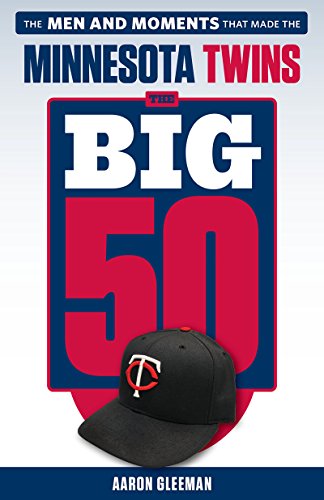March 7, 2014
Top 40 Twins Prospects of 2014: 35, 34, 33, 32, 31
Also in this series: 36-40.
35. Brian Gilbert | Reliever | DOB: 8/92 | Throws: Right | Draft: 2013-7
YEAR LV G GS ERA IP H HR SO BB
2013 RK+ 6 0 0.00 6.0 1 0 7 1
A- 13 0 1.06 17.0 12 0 7 0
Brian Gilbert split the 2011 and 2012 seasons between Seton Hall University's rotation and bullpen with mediocre results, but switched to relief work full time in 2013 and thrived in the closer role with a 2.40 ERA, .198 opponents' batting average, and 49 strikeouts in 49 innings. Drafted by the Twins in the seventh round, he signed for $120,000 and predictably dominated inexperienced hitters in the low minors during his pro debut.
He made six rookie-ball appearances and 13 more at low Single-A, posting a 0.78 ERA and 14/1 K/BB ratio in 23 innings while allowing zero homers after serving up just one long ball last year at Seton Hall. Gilbert issued 22 walks and uncorked six wild pitches in 49 college innings, so his control in the low minors was a surprise. Baseball America's pre-draft scouting report pegged his fastball at 92-95 miles per hour, but noted that his off-speed pitches need improvement.
College relievers tend to move quickly through a farm system if they perform well, so hopefully the Twins test Gilbert against some more experienced hitters and see if his raw stuff translates into missed bats higher up the organizational ladder. They also drafted his Seton Hall teammate, outfielder Zack Granite, in the 14th round and he hit .285/.362/.343 with 14 steals in 61 games at rookie-ball.
34. Corey Williams | Reliever | DOB: 7/90 | Throws: Left | Draft: 2011-3 YEAR LV G GS ERA IP H HR SO BB 2011 RK+ 7 0 3.86 11.2 12 0 11 5 2012 A- 47 0 3.47 62.1 55 5 68 33 2013 A+ 35 0 5.16 45.1 44 7 43 23
Corey Williams took a step backward last season, but it wasn't as big as his ERA jumping from 3.47 to 5.16 would suggest. Most of his secondary numbers remained similar, but the problem is that he spent a full season being sub par at high Single-A as a 22-year-old in his third pro season and hasn't improved upon his poor control since being drafted in the third round by the Twins out of Vanderbilt University in 2011.
Williams has totaled 125 strikeouts in 121 pro innings, which is good but not great for someone the Twins hoped would develop into a mid-90s throwing, late-inning reliever. More troubling are his 63 walks in 121 innings, along with a relatively high 12 homers allowed and struggles versus right-handed hitters. Last season righties had an .823 OPS against Williams and he also failed to shut down lefties after holding them to a .179 batting average in 2012.
This is a key season for Williams, who once signed for $575,000 but now appears to be on the verge of falling into the potential middle reliever or situational left-hander pile, which isn't home to many actual prospects. He throws hard, induces plenty of ground balls, and misses a fair number of bats, but his actual results have been underwhelming dating back to college and there is no shortage of intriguing relief prospects throughout the Twins' farm system.
33. Taylor Rogers | Starter | DOB: 12/90 | Throws: Left | Draft: 2012-11
YEAR LV G GS ERA IP H HR SO BB
2012 RK+ 6 6 1.80 30.0 20 2 39 5
A- 9 4 2.70 33.1 33 5 35 12
2013 A- 3 3 7.20 10.0 14 1 10 4
A+ 22 21 2.55 130.2 119 5 83 32
University of Kentucky pitchers have been popular Twins targets in recent drafts and that includes selecting left-hander Taylor Rogers in the 11th round two years ago. Rogers' college numbers were actually very ugly, as he went 13-18 with a 5.35 ERA while posting an ERA above 4.50 in all three seasons, but he's nearly halved that with a 2.69 ERA in two years as a pro. However, he's done that against Single-A hitters and with a high-80s fastball his prospect status is questionable.
Rogers' strikeout rate was very good at rookie-ball and low Single-A, but he's managed just 83 strikeouts in 131 innings at high Single-A and it's tough to take seriously a pitching prospect who can't crack six strikeouts per nine innings in the Florida State League. His control also hasn't been especially good, with 2.2 walks per nine innings at high Single-A, but Rogers did induce lots of ground balls while serving up a total of just five homers in 528 plate appearances there.
There are certainly plenty of soft-tossing lefties with poor strikeout rates who do just fine the big leagues, but for the most part they tended to have decent strikeout rates in the minors. Rogers shouldn't be written off as a total non-prospect and can do away with a lot of skepticism if he thrives at Double-A this season as a 23-year-old, but the odds are stacked against him and he lacks upside.
32. Tyler Duffey | Starter | DOB: 12/90 | Throws: Right | Draft: 2012-5
YEAR LV G GS ERA IP H HR SO BB
2012 RK+ 12 0 1.42 19.0 10 1 27 2
2013 A- 9 9 2.78 58.1 49 5 47 6
A+ 15 9 4.45 62.2 67 3 44 17
Two years ago the Twins drafted Rice University co-closers J.T. Chargois in the second round and Tyler Duffey in the fifth round. Chargois' career has been derailed by elbow surgery, but Duffey transitioned from reliever to starter at low Single-A last season with a lot of success, starting nine games with a 2.78 ERA and 47/6 K/BB ratio. Unfortunately he was considerably less impressive after being promoted to high Single-A and finished the year in the bullpen.
As a reliever at Rice and in his rookie-ball debut Duffey racked up tons of strikeouts, but last year as a starter he missed fewer bats and instead relied on very good control with an 83/20 K/BB ratio in 111 total innings. Those numbers match his raw stuff, which includes a low-90s fastball and slider/changeup off-speed repertoire, so it'll be interesting to see how long the Twins stick with Duffey as a starter.
Selecting college relievers and trying to turn them into professional starters was the focus of the Twins' draft in 2012 (well, that and picking some guy named Byron Buxton), but so far none of them have emerged as a standout starter prospect. Duffey and third-rounder Mason Melotakis look like the best bets right now, while Chargois and supplemental first-rounder Luke Bard have barely gotten out of the gates due to injuries.
31. Brett Lee | Starter | DOB: 9/90 | Throws: Left | Draft: 2011-10 YEAR LV G GS ERA IP H HR SO BB 2012 RK+ 16 4 2.68 43.2 39 3 48 12 2013 A- 23 19 2.95 116.0 117 7 89 26
Brett Lee was drafted in the late rounds by the Pirates in 2009 and the Dodgers in 2010 before signing with the Twins for $150,000 as a 10th-round pick out of St. Petersburg College in 2011. He had an excellent pro debut at rookie-ball in 2012 and then moved up to full-season competition last year, thriving at low Single-A with a 2.95 ERA and 89/26 K/BB ratio in 116 innings for Cedar Rapids.
Lee had the sixth-best walk rate in the Midwest League among all pitchers with at least 15 starts, but his strikeout rate of 6.9 per nine innings was actually below the league average of 7.6. Those numbers suggest that Lee is just another soft-tosser, of which the Twins never have a shortage, but he's actually a 6-foot-4 left-hander with decent velocity. Whether or not that ever translates into more missed bats is a key question for Lee's development.
Another reason to possibly be more excited about Lee's season than his overall numbers show is that he put together a fantastic second half with a 1.41 ERA and 45/8 K/BB ratio in 57 innings while holding opponents to a .204 batting average and one homer. Still not as many missed bats as you'd like to see, but eight walks and one homer in 57 innings is some awfully good pitching to contact and his ground-ball rate was strong as well.


Yay!
Comment by haplito — March 7, 2014 @ 10:56 am
Thanks for posting.
Comment by Chief Chief — March 7, 2014 @ 12:12 pm
Love the prospect top 40! Any insight into the methodology would be appreciated — not specific names if it’s interviews, of course, just a list like “X, Y, and Z publications and interviews with scouts/officials/experts.”
Comment by GagneWithASpoon — March 7, 2014 @ 1:36 pm
Super article ! Vos conseils sont bien pratiques et faciles à suivre. J’ai hâte de tester tout ça dans mes paris sur le football https://melbet-officialbetting.org/, le tennis, et même sur des jeux vidéo comme Dota 2. Merci de rendre le sujet aussi accessible !
Comment by Yara November — December 8, 2024 @ 4:02 pm